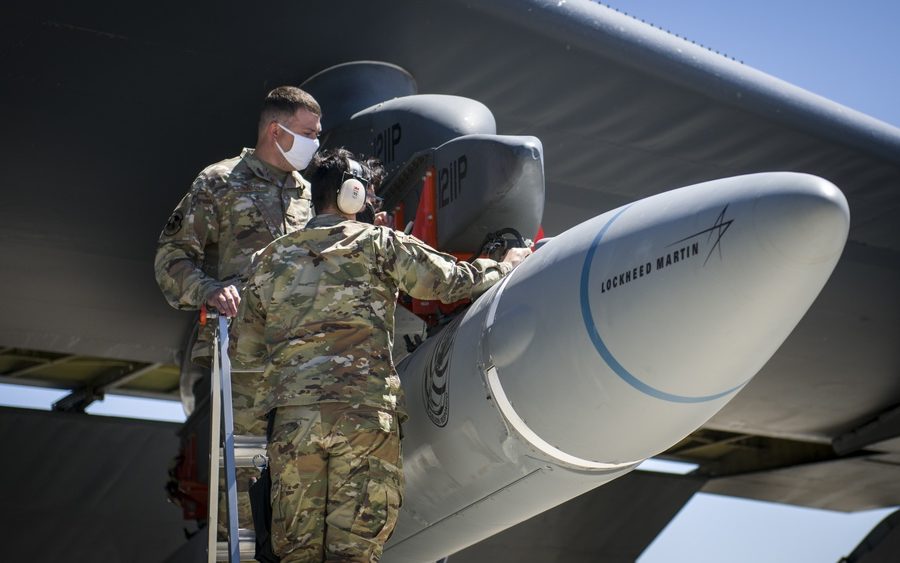The Air Force’s Air-launched Rapid Response Weapon may be running out of chances to prove its worth.
The service’s 2023 budget request does not include any procurement funds for the troubled hypersonics program, and though officials said they remain committed to the program in 2023, its future is less certain.
“[We’re] not walking away. It’s funded in FY 23,” Maj. Gen. James D. Peccia III, deputy assistant secretary for budget, told reporters. “And then we’ll make an assessment after that.”
ARRW has hit a number of setbacks recently, failing three booster flight tests in 2021—failing to leave the pylon in April, separating but failing to fire its booster in July, and once again not separating from the plane in December.
Those failures led to Congress stripping out the planned procurement of 12 ARRW missiles in the 2022 budget; the Air Force had asked for $160 million on the assumption that the tests would go smoothly, paving the way for the missile to rapidly enter service.
There is no plan to restore that procurement in 2023.
“There are no procurement quantities for ARRW in this budget,” Peccia. “There’s actually a … sliver of procurement for ARRW this year, but we expect to do a reprogramming with the Hill to move that into RDT&E, so there won’t be any procurement for ARRW in ‘23.”
Instead, the budget funds $577 million in research, development, test, and evaluation for the department’s hypersonic programs, which includes both ARRW and the Hypersonic Attack Cruise Missile. That marks a substantial increase from the $438 million requested in 2022, but those funds aren’t split evenly between the two.
“We increased funding for hypersonic weapons, for the ARRW and the HACM program, and primarily the increase lies within the HACM, the hypersonic cruise missile,” Peccia said.
HACM has received less funding than ARRW in the past, only really emerging as one of the Air Force’s top hypersonic efforts in the fall of 2020—it started receiving RDT&E funding as its own line item in fiscal 2022.
But in the March 28 budget rollout, officials highlighted HACM as a key line of effort for the Air Force’s hypersonic efforts.
“I think when it comes to hypersonic weapons, we’ve got to have the right mix, and so we’re committed not only to ARRW [but] as well as to HACM, and that’s why you see RDT&E funding for both of those,” Air Force Under Secretary Gina Ortiz Jones said.
The Air Force’s budget overview documents did not specify how much of the $577 million requested is intended for ARRW, a boost-glide weapon that is fired into the atmosphere and uses the energy from its rocket to fly toward its target, or HACM, which uses air-breathing engine technology for propulsion.
In providing an overview of the entire Defense Department’s hypersonic efforts, Vice Adm. Ronald A. Boxall, director of force structure, resources, and assessment for the Joint Staff, said the Air Force plans to field HACM by fiscal 2027, but he made no mention of when ARRW might enter service.
“This budget completes prototyping of the Air Force Air-launched Rapid Response Weapon, ARRW, and fields the Hypersonic [Attack] Cruise Missile, HACM, on the F-15 in 2027,” Boxall said.
Air Force Secretary Frank Kendall recently has cautioned against placing too much emphasis on hypersonic weapons simply to match China’s focus in the area. Instead, Kendall has hinted that hypersonic weapons may not be “cost-effective,” saying the service will likely only have small quantities of them as a result.
In a February webcast with the Air Force Association’s Mitchell Institute for Aerospace Studies, Kendall was noncommittal about whether ARRW’s testing woes could put it on the chopping block.
The ARRW “has had some test problems,” he acknowledged. “That’s not unusual in a development program.” Kendall said the Air Force is still investigating the most recent test failure, and he hopes “that we’re learning from that experience.” But the service will have to “make some decisions about that weapon system, … like everything else,” depending on the results of the investigation.
